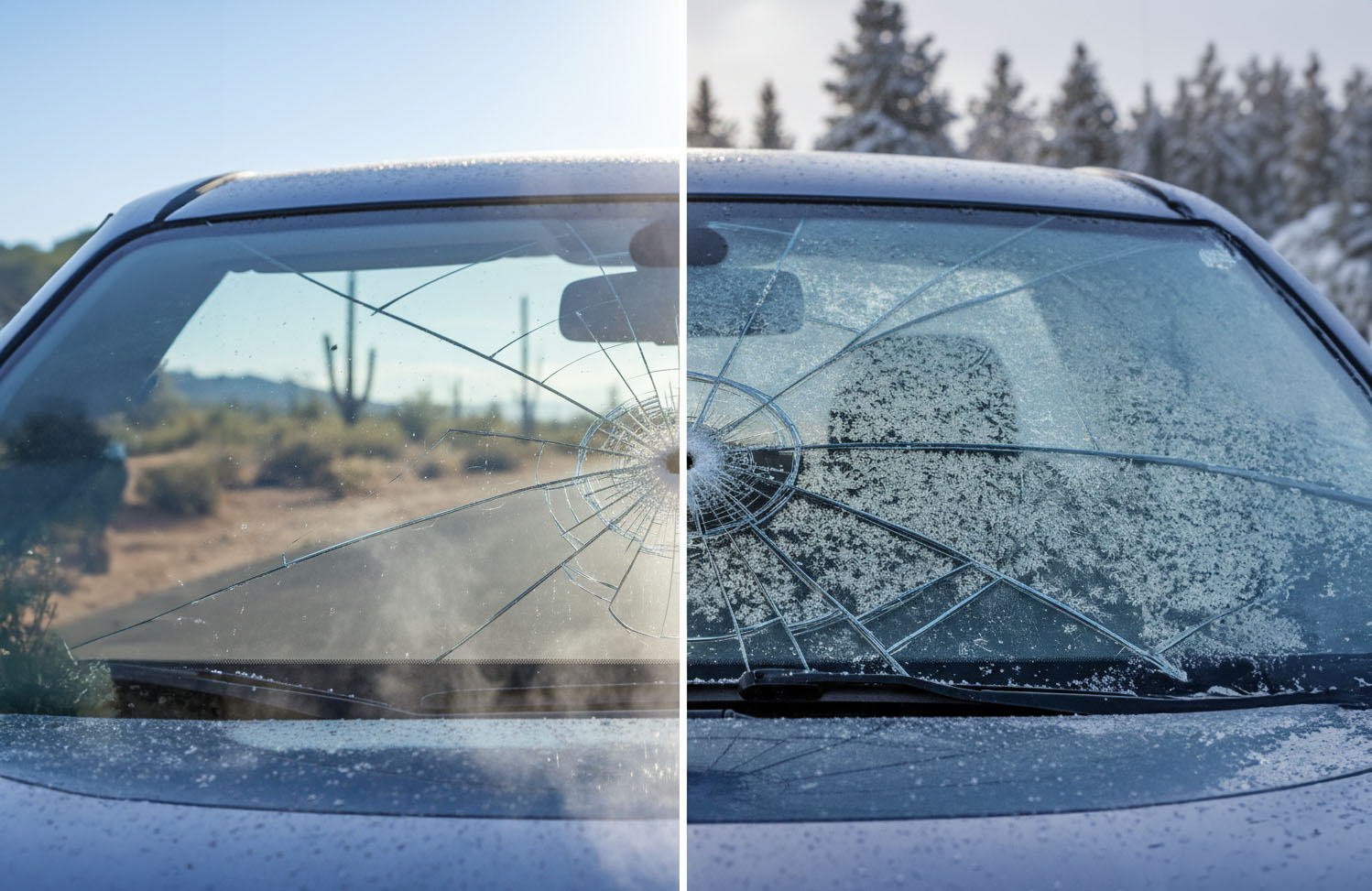Your windshield is one of the most overlooked parts of your vehicle, until a crack suddenly spreads across it. Extreme changing temperatures, such as going from a scorching hot day to an icy and frigid night (or vice versa), can cause stress to the glass and make small chips or cracks much worse. In some cases, temperature fluctuations alone are enough to create new damage. Understanding how temperature affects your windshield can help you prevent costly replacements and stay safe on the road.
How Temperature Changes Affect Your Windshield
Glass expands when it’s warm and contracts when it’s cold. This natural behavior might not seem like a big deal, but when the change happens quickly, or when the glass already has a small imperfection—the stress can cause significant damage.
1. Heat and Hot Weather
On a hot summer day, the surface of your windshield can reach temperatures well over 100°F, especially in direct sunlight. When this happens:
- The outer layer of glass expands faster than the inner layer.
- If there’s an existing chip or small crack, the uneven expansion can cause it to spread.
- Parking in direct sunlight or blasting the air conditioning right after getting into a hot car can create a rapid internal temperature change that worsens the stress on the glass.
2. Cold and Freezing Conditions
Cold weather poses a different type of risk. When the temperature drops:
- The glass contracts and becomes more brittle.
- Any moisture inside small cracks can freeze and expand, forcing the crack to grow.
- Using hot water or turning on the defroster at full heat immediately can shock the cold glass, often leading to new cracks.
3. Sudden Temperature Shifts
The biggest danger to your windshield comes from sudden temperature swings—like going from a freezing night to a warm morning, or quickly cooling down a hot windshield. These changes create internal stress that can cause chips to spiderweb or cracks to lengthen rapidly.
For instance, pouring warm water over an icy windshield may seem like a quick fix, but it can cause the glass to fracture instantly due to the extreme temperature difference.
Why Paying Attention to Temperature Shifts Matters
Your windshield is made of laminated safety glass—a strong combination of two glass layers with a plastic interlayer. While it’s designed to withstand impact and pressure, it’s still vulnerable to thermal stress.
By paying attention to temperature changes and avoiding sudden extremes, you can:
- Prevent small cracks from spreading into larger, irreparable ones.
- Avoid unnecessary replacements, saving money in the long run.
- Maintain the integrity of your ADAS systems, like lane departure or automatic braking, which rely on precise windshield calibration.
- Keep visibility clear and reduce the risk of accidents caused by glare or distortion from cracks.
How to Prevent Cracks from Spreading or Forming
You can’t control the weather, but you can protect your windshield from temperature-related stress. Here are some practical tips:
- Avoid sudden heating or cooling. Gradually warm your windshield with the defroster instead of cranking up the heat.
- Park in the shade or a garage. This prevents direct exposure to sunlight in summer and limits frost buildup in winter.
- Use a windshield cover. It helps regulate temperature and protects against UV rays.
- Don’t pour hot or cold water on your windshield—it’s a shortcut that can cause instant cracks.
- Repair small chips immediately. Even a minor chip can expand into a full crack when temperatures fluctuate.
- Replace the windshield when necessary. If cracks are large or deep, replacement is the only safe option.
Why Timely Repair or Replacement Is Important
Small cracks or chips might not seem urgent, but they can quickly turn into bigger problems:
- Structural integrity: The windshield provides up to 60% of your vehicle’s structural strength in a rollover accident. Damaged glass weakens this support.
- Visibility: Cracks distort your view, especially in bright sunlight or at night.
- Safety systems: Modern vehicles have sensors and cameras mounted behind the windshield that require perfect alignment and calibration. A cracked or replaced windshield must be recalibrated to ensure these systems work correctly.
If a chip is smaller than a quarter, it can often be repaired. But if it’s larger, in the driver’s line of sight, or at the edges of the glass, replacement is the safest and most reliable option.
Finding a Trustworthy Windshield Replacement Shop
When it’s time to repair or replace your windshield, finding a reliable auto glass shop is key. Look for certified technicians, OEM-quality glass, and proper calibration services if your car has ADAS features.
At AutoGlassEstimator.com, you can use our free quote tool to quickly compare prices and find trusted windshield repair and replacement shops near you. It’s fast, easy, and helps you get the best service without overpaying.
Final Thoughts
Temperature changes may seem harmless, but they can be one of the most damaging factors for your windshield. From blistering heat to freezing cold, your auto glass faces constant stress that can worsen even the smallest chip. Acting fast, whether by repairing a small chip or replacing a damaged windshield—keeps you safe, saves money, and ensures your vehicle performs as it should.
Don’t wait for a small crack to become a major safety risk. Use our free quote tool today to find a trusted windshield repair or replacement shop near you.

To read more visit our Blog
